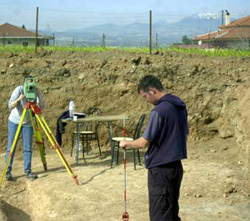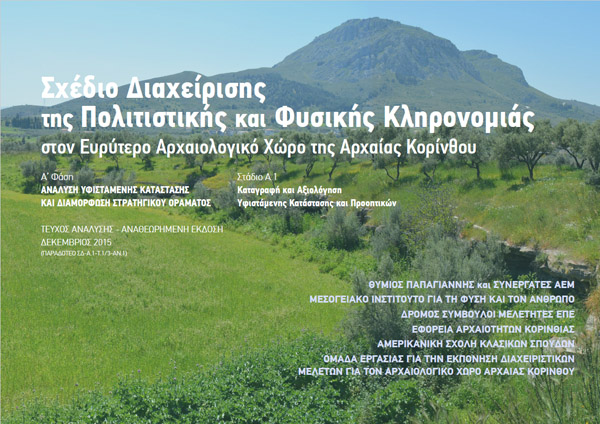Current Research Projects

As well as being engaged in continuing excavations of the site, the School is involved in a number of other research projects related to Corinth. Affiliated projects and scholars are also investigating other parts of the Corinthia, the region around the city, at a variety of levels ranging from intensive survey of larger areas to excavation at specific sites. The rapid construction that occurred in the Corinthia in the recent decade is limiting the amount of land that can be studied through excavation. In response, the Corinth excavations are working to record antiquities using a variety of methods.
Heritage Management
In June 2014, the American School of Classical Studies in collaboration with the former 37thEphorate of Prehistoric and Classical Antiquties and the former 25thEphorate of Byzantine Antiquities and funding from the J.M. Kaplan Fund organized the three-day (June 20-22) workshop “Planning for Sustainable Heritage in Ancient Corinth”. Participants included staff of the ASCS, the former 37thEphorate of Prehistoric and Classical Antiquties, the former 25thEphorate of Byzantine Antiquities with their respective Directorates, as well as experts in monuments conservation and management (Martha Demas, John Fidler, Frank Matero, Clairy Palyvou). Representatives of the regional, municipal and local authorities were also invited to attend. The goal was to lay down the principles and objectives of a management plan for the archaeological site of Ancient Corinth through a collaboration between the ASCS and the Hellenic Ministry of Culture and Sports.
Systematic efforts for the management plan began in December 2014, with the appointment of an official working group by the Ministry of Culture. With the appropriate funding from the J. M. Kaplan Fund, the working group was able to complete the first phase. The goals of the plan is to preserve and enhance the values of the archaeological site and to ensure the long-term and sustainable management of the area’s natural and cultural resources. In addition, the plan aims at creating an attractive, accessible, and multifunctional heritage site that can contribute to the area’s socio-economic development, while supporting the wealth and significance of its cultural and natural resources. Stakeholder participation in the planning and implementation stages, as well as community involvement through education and outreach programs are important aspects of the management plan.

During the first phase of planning, architect Giorgos Ninos with Foteini Belliou, Ioanna Dogani, and Amerimne Galanou completed the inventory and condition assessment of over 200 monuments. The architectural firm ThymiosPapagiannis and Associates and the Mediterranean Institute for Nature and Anthropos (MedINA) prepared, in collaboration with the working group, the volume of the plan’s first phase. This volume includes a documentation of the characteristics of the wider area of Corinth and Ancient Corinth specifically (social and economic characteristics, spatial planning, agriculture, tourism), a documentation of the natural environment and ecological aspects of the area, issues of cultural heritage and landscape protection and urban planning policies, as well as an assessment of the site’s supporting infrastructure (museum, storerooms, conservation facilities, working spaces, access, traffic, signage, parking etc.).The second, and final, phase of the plan, which includes the development of proposals and an action plan for the effective management of the archaeological site, currently awaits funding.
Topographic Surveying
Since 1988 the Corinth Computer Project (CCP), led by Dr. David Gilman Romano from the Mediterranean Section of the University of Pennsylvania Museum of Archaeology and Anthropology, has been involved in making a computerized architectural and topographical survey of the Roman colony of Corinth. Field work ended in 1997 and Dr. Romano is preparing material for final publication.
Corinth Excavations has continued this topographical research. We aim to compliment the work of the CCP recording antiquities throughout the region in a GIS database while expanding the data set to include geophysical data, excavation and artifact data, and many ΛΖ ephoreia rescue excavations. Preliminary work began in 2001 and in 2002 we surveyed monuments at the Amphitheater, Kraneion, the gymnasium, the Panayia Field. Several volunteers assisted, including Alicia Carter, Kostis Korelis, and Christopher Pfaff. In the winter of 2002, two regular members of the ASCSA, Jen Palinkas and Dorian Borbonus, volunteered while learning surveying skills. Work was furthered with a focus on Byzantine phases of the Forum in 2004 with Daria Gulec and Pietro Riavez. Bill Caraher of the EKAS survey generously expanded the topographical database and aerial photos in the eastern Corinthia. In 2005 and 2006 we recorded the ΛΖ ΕΠΚΑ ephoreia’s rescue excavations including the location of a post-Classical phase of the road to Sikyon, the western long wall of the Classical city walls, and an extensive cemetery of Geometric, Archaic, Classical and Roman burials. The Classical buildings I-IV, Pierene, and the Cyclopean Fountain were also re-surveyed in conjunction with the publication needs of Betsy Pemberton, Ian McPhee, and Betsey Robinson. In 2009 rescue excavations north of the Demeter Sanctuary were recorded.
Spatial data generated by Corinth Excavations is shared freely on a regular basis with students and scholars and can be requested by email to the Corinth Excavation’s architect. We eagerly await the integration of the Corinth Excavations and CCP data which will provide scholars with unprecedented spatial coverage of archaeological data of the region. In 2018, a dGPS was purchased with generous donations
Environmental Remote Sensing
Since 1998, Dr. Michael Boyd of the University of Sheffield, UK, has been conducting resistivity survey under the auspices of the ASCSA. In this method of remote sensing, two probes placed in the soil measure the electrical resistance in a single square meter of earth. From the measurements a computer image is generated in which stone shows in red (high resistance) while soil is blue (low resistance), and a rough picture of features beneath the surface can be obtained. To date over 58 stremata (58,000 square meters) have been surveyed in several areas, including south of the Gymnasium; the west side of Panayia Field; and the prehistoric site of Korakou. This work aims to provide a plan of architectural density of large areas of the Corinthia. Compared to excavation, resistivity survey is quick, inexpensive and non-destructive. From the data collected, places that require further archaeological investigation can be determined. Short descriptions of the findings can be found in the excavation reports. In addition to several students from the British School at Athens, many volunteers from the ASCSA have given time to this project including Camilla MacKay, Bronwen Wickkiser, Jen Palinkas, Dorian Borbonius, Larry Myer, Joann Gulizio, Kevin Pluta, Brenda Longfellow, and Alicia Carter.
